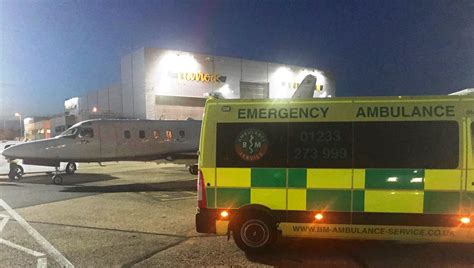When it comes to emergency medical situations, every minute counts. In the high-pressure environment of an airport, where thousands of people pass through every day, having a reliable and efficient emergency medical response system in place is crucial. This is where airport ambulance services come in, providing critical medical care to those in need.
The Importance of Airport Ambulance Services
Airports are complex ecosystems that require specialized emergency medical response systems. With the constant flow of passengers, airport staff, and flight crews, the risk of medical emergencies is ever-present. Whether it's a heart attack, stroke, or injury, airport ambulance services play a vital role in providing immediate medical attention and transportation to a hospital if needed.
How Airport Ambulance Services Work
Airport ambulance services are typically provided by trained emergency medical technicians (EMTs) and paramedics who are stationed at the airport. These medical professionals are equipped with state-of-the-art ambulances and medical equipment to respond to a wide range of emergencies.
When an emergency call is made, the airport's emergency response system springs into action. The ambulance crew is dispatched to the scene, where they assess the patient's condition and provide medical care as needed. If the patient requires hospitalization, the ambulance crew will transport them to a nearby medical facility.

Benefits of Airport Ambulance Services
Airport ambulance services offer several benefits to passengers, airport staff, and the airport authority. Some of these benefits include:
- Quick response times: Airport ambulance services are able to respond quickly to emergencies, which is critical in saving lives.
- Specialized medical care: Airport ambulance crews are trained to handle a wide range of medical emergencies, from minor injuries to life-threatening conditions.
- Efficient transportation: Airport ambulances are equipped with state-of-the-art medical equipment and are staffed by trained medical professionals, ensuring that patients receive the best possible care during transportation.
- Reduced risk of complications: By providing immediate medical attention and transportation to a hospital, airport ambulance services can help reduce the risk of complications and improve patient outcomes.
The Role of Technology in Airport Ambulance Services
Technology plays a critical role in airport ambulance services, enabling emergency responders to respond quickly and effectively to medical emergencies. Some of the ways technology is used in airport ambulance services include:
- Emergency response systems: Airports use advanced emergency response systems to quickly respond to medical emergencies. These systems include emergency phones, panic buttons, and mobile apps that allow passengers and staff to quickly call for help.
- GPS tracking: Airport ambulances are equipped with GPS tracking systems that enable dispatchers to track the location of the ambulance and respond quickly to emergencies.
- Electronic patient care records: Airport ambulance crews use electronic patient care records to document patient information and medical treatment. This information can be shared with hospitals and other medical providers to ensure continuity of care.

Challenges Facing Airport Ambulance Services
Despite the importance of airport ambulance services, there are several challenges that these services face. Some of the challenges include:
- Limited resources: Airport ambulance services often have limited resources, including personnel, equipment, and funding.
- High demand: Airports are busy places, and airport ambulance services must be able to respond quickly to a high volume of medical emergencies.
- Security protocols: Airport ambulance services must navigate security protocols to respond to emergencies, which can be time-consuming and challenging.
Best Practices for Airport Ambulance Services
To provide effective airport ambulance services, airports and emergency medical providers must follow best practices. Some of these best practices include:
- Regular training and drills: Airport ambulance crews should participate in regular training and drills to ensure that they are prepared to respond to a wide range of medical emergencies.
- Collaboration with airport authorities: Airport ambulance services should work closely with airport authorities to ensure that they are aware of airport operations and can respond quickly to emergencies.
- Use of technology: Airport ambulance services should leverage technology to respond quickly and effectively to medical emergencies.

Future of Airport Ambulance Services
The future of airport ambulance services is likely to be shaped by advances in technology and changes in airport operations. Some of the trends that are likely to shape the future of airport ambulance services include:
- Increased use of technology: Airport ambulance services are likely to leverage technology, including artificial intelligence and the Internet of Things, to respond quickly and effectively to medical emergencies.
- Greater emphasis on prevention: Airport ambulance services may place a greater emphasis on prevention, including providing education and resources to passengers and staff to prevent medical emergencies.
- Changes in airport operations: Changes in airport operations, including the use of biometrics and artificial intelligence, may impact the way airport ambulance services respond to medical emergencies.






In conclusion, airport ambulance services play a critical role in providing emergency medical response on the ground. By leveraging technology, following best practices, and staying ahead of trends, airport ambulance services can continue to provide effective and efficient medical care to those in need.
We hope this article has provided you with a comprehensive understanding of airport ambulance services. Whether you're a passenger, airport staff, or emergency medical provider, it's essential to be aware of the importance of airport ambulance services and the role they play in keeping airports safe.
If you have any questions or comments, please don't hesitate to reach out. We'd love to hear from you!
FAQ:
What is the primary role of airport ambulance services?
+The primary role of airport ambulance services is to provide emergency medical response and transportation to passengers and staff at airports.
What types of emergencies do airport ambulance services respond to?
+Airport ambulance services respond to a wide range of medical emergencies, including heart attacks, strokes, injuries, and other life-threatening conditions.
How do airport ambulance services use technology to respond to emergencies?
+Airport ambulance services use technology, including GPS tracking and electronic patient care records, to respond quickly and effectively to medical emergencies.
